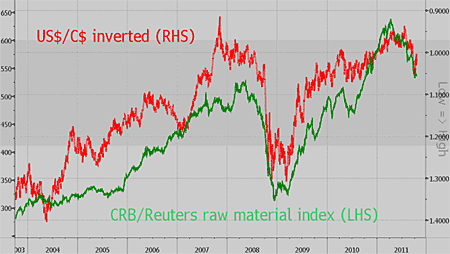Almost every ‘developed’ economy in the world has struggled badly since the Great Recession of 2008/09.
Not Canada. The country’s economy has bounced back rapidly from its recession low.
What’s more, it’s managed to do so without going spending-crazy. This year’s government budget deficit (the shortfall of tax revenues against state spending) will only be about 3% of GDP. Compared with the near-double-digit deficits that seem the norm these days, that’s remarkable.
So is Canada the new ‘safe haven’ for your money? Not so fast. Canada is more vulnerable than it might look.
How did Canada get through the economic crisis?
“With Canada’s close economic ties to the United States, how has it escaped the brunt of the continuing recession plaguing the US and Europe?” asked Bob Edelman in New American recently.
Good question. Canada’s 2008/09 recession lasted just three quarters, so the country got off lightly compared with the rest of the developed world.
What’s more, Canadian GDP has rebounded so well, that it’s now 2% higher than its previous peak three years ago. In contrast, the US and UK have yet to recover to where they were.
And this growth is paying dividends for the Canadian population. There are more jobs around now than in 2008. Unemployment is just 7%. That stacks up against 8.1% in the UK, 9.1% in America and some quite horrendous dole queues in Europe.
So what’s the secret?
Canada’s government went into the 2008/09 recession in a very strong financial position. In fact, it had been running a budget surplus for years, having cut the national debt – what the country owes – to below 40% of GDP.
That’s because the country grasped the nettle of state overspending back in the 1990s. Prime minister Jean Chretien and finance minister Paul Martin realised they had to focus on debt reduction or Canada would be in hock for years. So they did.
The approach certainly paid off. While the US has recently lost its AAA-credit score rating, there’s no chance of Canada going the same way.
That’s because, rather than trying to spend its way back to economic growth, Canada cut back on state spending and let the recession run its course. That allowed the private sector to kick start the recovery. And that’s why Canada bounced back so well – because the government hasn’t got in the way, reckons David Lee on Mises.org.
Why Canada remains vulnerable to a double-dip
Yet despite this performance, Canada has still suffered. Its stock market has fallen almost twice as far as the US S&P 500 index this year.
So you might at this point expect me to tip some cheap Canadian stocks. And in the long run, Canada will certainly offer some great opportunities.
But the short term is a different matter. The trouble is, for all its resilience, Canada is a major global commodity producer. So it’s unlikely to be immune to another big economic dip.
Because as John Stepek noted last week, this time China looks set to slow down sharply too. And it will have too much to sort out on the home front (like surging food prices) to be able to bail out growth in the rest of the world.
“Canada has come though the financial crisis relatively well”, says Edmund Clark, boss of Toronto-Dominion Bank. “But looking forward we face many of the same challenges as the western world. The prolonged period of [global] slow growth expected will have a profound effect on Canada’s recovery and economy”.
And Canada has another problem, which it shares with much of the rest of the developed world. The public sector might be in reasonable shape. But its consumers are heavily indebted.
The ratio of credit market debt (mortgages, consumer credit and loans) to disposable incomes is around 150%. That’s higher than in the US. And Canadian incomes are growing much more slowly than this debt. So there’s little scope for consumers to spend more to offset the adverse effects of weak commodity prices on the economy.
All in all, the short-term outlook for Canada isn’t too bright. Happily for Canadian consumers, interest rates are no longer rising, so they won’t have to pay more to service their debts.
But it’s a negative for Canada’s currency, known as the Loonie. Holders of the Loonie will receive lower returns than they might have expected when interest rates were climbing.
And in fact, this is where the moneymaking opportunity – at least for traders – now lies.
It’s time to short-sell the Loonie
Look at the chart below:

(Source: Bloomberg)
The red line is the Loonie compared with the US$. When the red line falls, the Loonie is dropping compared with the buck. And remember all those commodities that Canada churns out? They’re indicated by the green line: the CRB/Reuters raw material index.
History shows that when commodity prices drop, so does the Loonie. And if a big global economic slowdown is looming, that’s what’s on the cards for Canada’s currency.
You can trade the Loonie versus the US dollar using spread betting. If you’d like to have a crack at this, our spread betting page can point you in the right direction. And if you’d also like some handy hints on how to trade, sign up for John C Burford’s free MoneyWeek Trader email.
Category: Economics

